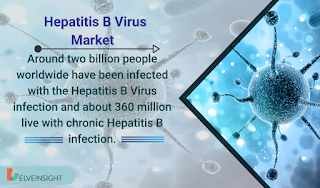Dravet Syndrome Market Size & Share, Market Trends, Market Research Report 2030
Dravet syndrome (DS) is a rare, catastrophic, lifelong form of epilepsy that begins in the first year of life with frequent and/or prolonged seizures.
Dravet
Syndrome has been defined as a severe form of epilepsy characterized by
frequent, prolonged seizures often triggered by high body temperature
(hyperthermia), developmental delay, speech impairment, ataxia, hypotonia,
sleep disturbances, and other health problems.
DelveInsight’s ‘Dravet
Syndrome Market Insights, Epidemiology, and Market Forecast – 2030’ report
deliver an in-depth understanding of the disease, historical and forecasted
epidemiology as well as the market trends of Dravet Syndrome (DS) in the United
States, EU5 (Germany, France, Italy, Spain, and the United Kingdom), and Japan.
The Dravet Syndrome market report provides analysis
regarding current treatment practices, emerging drug-like Cannabidiol,
potential therapies, market share of the individual therapies, historical,
current and forecasted Dravet Syndrome market size from 2017 to 2030 segmented
by seven major markets.
The report also covers current Dravet Syndrome treatment practice/algorithm, market drivers, market barriers and unmet medical needs to curate best of the opportunities and assess the underlying potential of the market.
Geography Covered
·
The United States
·
EU5 (Germany, France, Italy, Spain, and the United
Kingdom)
·
Japan
Study Period: 2017–2030
Dravet Syndrome - Disease Understanding and Treatment Algorithm
Dravet Syndrome Overview
Dravet Syndrome is a severe form of epilepsy characterized by frequent, prolonged seizures often triggered by high body temperature (hyperthermia), developmental delay, speech impairment, ataxia, hypotonia, sleep disturbances, and other health problems.
It occupies a very distinct place among rare and severe epilepsies, which is quite evident from the names it was given during its short and eventful history. Initially “Severe myoclonic epilepsy of infancy” (SMEI) was distinguished from Lennox–Gastaut syndrome (LGS) which was then considered as the most common severe epilepsy of childhood, and with which it shared pharmacoresistance, episodes of status epilepticus (SE) and intellectual disability.
Three stages are usually identified in association with DS with “Febrile stage” being the first among them, Worsening stage” follows between 1 and 5 years of age and “Stabilization stage” begins by the end of the first decade in which seizures are less frequent
The Signs and Symptoms of the
disease involve seizures, ataxia (balance problems), motor impairment, cognitive
impairment, behavioral problems, infections, bone problems, and heart rhythm irregularities.
Dravet Syndrome Treatment
This chapter covers the details of conventional and current medical therapies available in the Dravet Syndrome market for the treatment of the condition. It also provides the country-wise Dravet Syndrome treatment guidelines across the United States, Europe and Japan.
DelveInsight’s Dravet Syndrome market report gives a thorough understanding of the disease by including details such as disease definition, symptoms, types, grading, pathophysiology, and diagnosis. It also provides Dravet Syndrome treatment algorithms and treatment guidelines in the US, Europe, and Japan.
Dravet Syndrome Epidemiology
The Dravet Syndrome epidemiology chapters provide insights about historical and current Dravet Syndrome patient pool and forecasted trend for every seven major countries. It helps to recognize the causes of current and forecasted trends by exploring numerous studies and views of key opinion leaders. Incidence of Dravet Syndrome segments Dravet Syndrome epidemiology, Mutation positive cases, Mutation Cases by Types and Class, Seizures associated with Dravet Syndrome, Gender-specific cases and Age-specific cases of Dravet Syndrome. The report includes thorough analysis of all segmentations.
Mutation Positive Cases in Dravet Syndrome can be divided into two subtypes: by types (SCN1A mutation associated with DS and other rare mutations associated with DS) and by class (Missense, Nonsense, Frameshift, Splice site, Inframe Insertion/Deletion and Gross Rearrangements). In the US, the cases of mis-sence mutation in Dravet Syndrome were found to be 6,734 in 2017. Moreover, the cases of SCN1A mutation associated with DS were reported to be 13,175 in the country.
According to DelveInsight’s, the total incident population of Dravet Syndrome in seven major markets was 30,820 in 2017. These cases are expected to increase with a significant CAGR during the study period (2017–2030).
Among all the seven major markets, the United States accounts for the highest number of Dravet Syndrome cases.
Dravet Syndrome Drug Chapters
Drug chapter segment of the Dravet Syndrome report encloses the detailed analysis of Dravet Syndrome pipeline drug. It also helps to understand the Dravet Syndrome clinical trial details, expressive pharmacological action, agreements of included drug and the latest news and press releases.
The primary aim in managing patients with DS is to significantly reduce seizure frequency (particularly prolonged events) and limit antiepileptic drug toxicity First-line management typically involves either valproic acid or clobazam. Zogenix’s ZX008, Ovid/Takeda’s Soticlestat and PTC Therapeutics’s Ataluren are the only therapies in pipeline.
Dravet Syndrome Market Outlook
The Dravet Syndrome market size is expected to increase at a significant CAGR during the study period (2017–2030). Among all the seven major markets, the United States accounts for the highest Dravet Syndrome market size. Among EU5 countries, the United Kingdom had the highest market size with USD 3.9 million in 2017, while Spain had the lowest market size of DS with USD 1.9 million in 2017.
Request for sample pages: https://www.delveinsight.com/sample-request/dravet-syndrome-market
Download full report: https://www.delveinsight.com/report-store/dravet-syndrome-market


Comments
Post a Comment